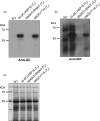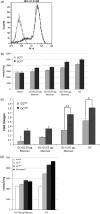The production of human glucocerebrosidase in glyco-engineered Nicotiana benthamiana plants
- PMID: 26868756
- PMCID: PMC5067671
- DOI: 10.1111/pbi.12529
The production of human glucocerebrosidase in glyco-engineered Nicotiana benthamiana plants
Abstract
For the production of therapeutic proteins in plants, the presence of β1,2-xylose and core α1,3-fucose on plants' N-glycan structures has been debated for their antigenic activity. In this study, RNA interference (RNAi) technology was used to down-regulate the endogenous N-acetylglucosaminyltransferase I (GNTI) expression in Nicotiana benthamiana. One glyco-engineered line (NbGNTI-RNAi) showed a strong reduction of plant-specific N-glycans, with the result that as much as 90.9% of the total N-glycans were of high-mannose type. Therefore, this NbGNTI-RNAi would be a promising system for the production of therapeutic glycoproteins in plants. The NbGNTI-RNAi plant was cross-pollinated with transgenic N. benthamiana expressing human glucocerebrosidase (GC). The recombinant GC, which has been used for enzyme replacement therapy in patients with Gaucher's disease, requires terminal mannose for its therapeutic efficacy. The N-glycan structures that were presented on all of the four occupied N-glycosylation sites of recombinant GC in NbGNTI-RNAi plants (GC(gnt1) ) showed that the majority (ranging from 73.3% up to 85.5%) of the N-glycans had mannose-type structures lacking potential immunogenic β1,2-xylose and α1,3-fucose epitopes. Moreover, GC(gnt1) could be taken up into the macrophage cells via mannose receptors, and distributed and taken up into the liver and spleen, the target organs in the treatment of Gaucher's disease. Notably, the NbGNTI-RNAi line, producing GC, was stable and the NbGNTI-RNAi plants were viable and did not show any obvious phenotype. Therefore, it would provide a robust tool for the production of GC with customized N-glycan structures.
Keywords: N-acetylglucosaminyltransferase I; Nicotiana benthamiana; glyco-engineered plant; human glucocerebrosidase; plant-made pharmaceuticals.
© 2016 The Authors. Plant Biotechnology Journal published by Society for Experimental Biology and The Association of Applied Biologists and John Wiley & Sons Ltd.
Figures







Similar articles
-
Production of recombinant β-glucocerebrosidase in wild-type and glycoengineered transgenic Nicotiana benthamiana root cultures with different N-glycan profiles.J Biosci Bioeng. 2022 May;133(5):481-488. doi: 10.1016/j.jbiosc.2022.01.002. Epub 2022 Feb 18. J Biosci Bioeng. 2022. PMID: 35190260
-
Generation of glyco-engineered Nicotiana benthamiana for the production of monoclonal antibodies with a homogeneous human-like N-glycan structure.Plant Biotechnol J. 2008 May;6(4):392-402. doi: 10.1111/j.1467-7652.2008.00330.x. Epub 2008 Mar 13. Plant Biotechnol J. 2008. PMID: 18346095
-
Deletion of plant-specific sugar residues in plant N-glycans by repression of GDP-D-mannose 4,6-dehydratase and β-1,2-xylosyltransferase genes.J Biosci Bioeng. 2014 Oct;118(4):448-54. doi: 10.1016/j.jbiosc.2014.04.005. Epub 2014 May 3. J Biosci Bioeng. 2014. PMID: 24794851
-
Bioproduction of human enzymes in transgenic tobacco.Ann N Y Acad Sci. 1996 May 25;792:62-71. doi: 10.1111/j.1749-6632.1996.tb32492.x. Ann N Y Acad Sci. 1996. PMID: 8678421 Review.
-
Tobacco against Ebola virus disease.Przegl Lek. 2015;72(10):567-71. Przegl Lek. 2015. PMID: 26946569 Review.
Cited by
-
Recent Developments in Deciphering the Biological Role of Plant Complex N-Glycans.Front Plant Sci. 2022 Apr 25;13:897549. doi: 10.3389/fpls.2022.897549. eCollection 2022. Front Plant Sci. 2022. PMID: 35557740 Free PMC article. Review.
-
N-glycan Remodeling Using Mannosidase Inhibitors to Increase High-mannose Glycans on Acid α-Glucosidase in Transgenic Rice Cell Cultures.Sci Rep. 2018 Oct 31;8(1):16130. doi: 10.1038/s41598-018-34438-z. Sci Rep. 2018. PMID: 30382146 Free PMC article.
-
A baculoviral system for the production of human β-glucocerebrosidase enables atomic resolution analysis.Acta Crystallogr D Struct Biol. 2020 Jun 1;76(Pt 6):565-580. doi: 10.1107/S205979832000501X. Epub 2020 May 29. Acta Crystallogr D Struct Biol. 2020. PMID: 32496218 Free PMC article.
-
Enhancement of sialylation in rIgG in glyco-engineered Chinese hamster ovary cells.Cytotechnology. 2020 Jun;72(3):343-355. doi: 10.1007/s10616-020-00381-z. Epub 2020 Mar 3. Cytotechnology. 2020. PMID: 32125558 Free PMC article.
-
Artificial intelligence-driven systems engineering for next-generation plant-derived biopharmaceuticals.Front Plant Sci. 2023 Nov 15;14:1252166. doi: 10.3389/fpls.2023.1252166. eCollection 2023. Front Plant Sci. 2023. PMID: 38034587 Free PMC article. Review.
References
-
- Altmann, F. (2007) The role of protein glycosylation in allergy. Int. Arch. Allergy Immunol. 142, 99–115. - PubMed
-
- Becker, D. , Kemper, E. , Schell, J. and Masterson, R. (1992) New plant binary vectors with selectable markers located proximal to the left T‐DNA border. Plant Mol. Biol. 20, 1195–1197. - PubMed
-
- Bencurova, M. , Hemmer, W. , Focke, T. , Wilson, I. and Altmann, F. (2004) Specificity of IgG and IgE antibodies against plant and insect glycoprotein glycans determined with artificial glycoforms of human transferrin. Glycobiology, 14, 457–466. - PubMed
-
- Bosch, D. , Castilho, A. , Loos, A. , Schots, A. and Steinkellner, H. (2013) N‐glycosylation of plant‐produced recombinant proteins. Curr. Pharm. Des. 19, 5503–5512. - PubMed
-
- Brumshtein, B. , Peterson, B. , Chan, V. , Silman, I. , Sussman, J.L. , Savickas, P.J. , Robinson, G.S. and Futerman, A.H. (2010) Characterization of gene‐activated human acid‐ glucosidase: Crystal structure, glycan composition, and internalization into macrophages. Glycobiol. 20, 24–32. - PMC - PubMed
MeSH terms
Substances
LinkOut - more resources
Full Text Sources
Other Literature Sources
Miscellaneous

